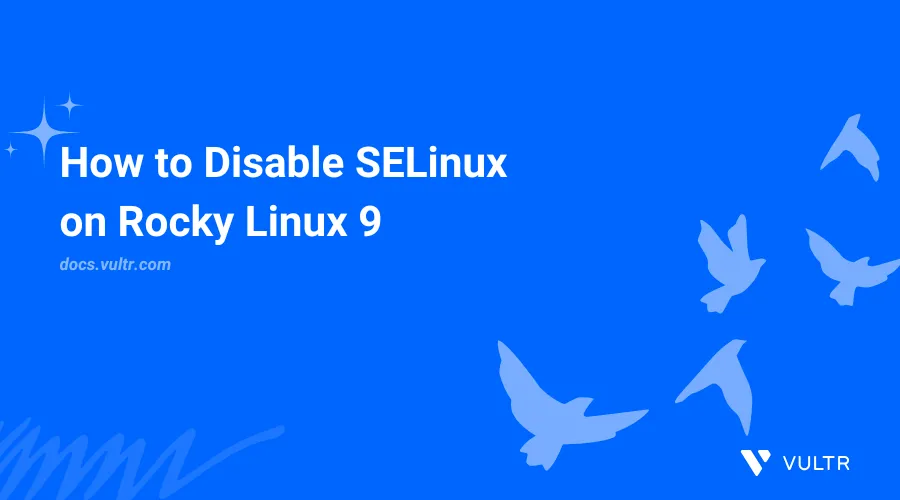
Security-Enhanced Linux (SELinux) is a mandatory access control (MAC) system that enforces strict security policies on Linux platforms. To adjust these controls, you might need to disable SELinux on Rocky Linux 9, especially if certain applications require more permissive access. SELinux is enabled by default on Rocky Linux to protect the system by limiting unauthorized interactions.
While it is not recommended to disable SELinux on production systems, some applications may require it to be disabled due to compatibility issues. This guide explains how to check the SELinux status, temporarily disable SELinux, and permanently disable SELinux on Rocky Linux 8 and 9.
SELinux Modes
SELinux operates in three different modes.
- Enforcing: SELinux policies are actively enforced, restricting unauthorized access. This mode is recommended for production systems.
- Permissive: SELinux policies are not enforced, but violations are logged. This mode is useful for debugging and testing.
- Disabled: SELinux policies are completely turned off. This mode is not recommended as it removes all access controls.
Prerequisites
Before you begin, you need to:
- Have access to a Rocky Linux 9 instance as a non-root sudo user.
Check SELinux Status
SE Linux is enabled by default on Rocky Linux 9. Follow the steps below to check the default SELinux status before disabling it on your workstation.
Check the SELinux status.
console$ sudo sestatus
Your output should look like the one below.
SELinux status: enabled Current mode: enforcingThe
sestatuscommand outputs the system's SELinux status and Current mode. For a filtered output, use:console$ sudo sestatus | grep 'SELinux status\|Current mode'
Temporarily Disable SELinux on Rocky Linux 9
Follow the steps below to temporarily disable SELinux until the next reboot.
Temporarily disable SELinux.
console$ sudo setenforce 0
Verify the SELinux status.
console$ sudo sestatus | grep 'SELinux status\|Current mode'
Output:
SELinux status: enabled Current mode: permissiveBased on the above output, the current mode is now permissive, and this change will persist until the next reboot. Reboot the system using
sudo rebootand runsudo sestatusagain to verify that the mode changes back to enforcing.
Permanently Disable SELinux
Permanently disabling SELinux is not recommended on Rocky Linux 9. Only disable SELinux on Rocky Linux 9 if other security mechanisms such as firewalls are enabled. Follow the steps below to permanently disable SELinux on your workstation.
Open the main SELinux configuration file using a text editor such as
nano.console$ sudo nano /etc/selinux/config
Find the
SELINUX=directive and change its value todisabled:ini# This file controls the state of SELinux on the system. # SELINUX= can take one of these three values: # enforcing - SELinux security policy is enforced. # permissive - SELinux prints warnings instead of enforcing. # disabled - No SELinux policy is loaded. SELINUX=disabled
Save and close the file.
Reboot the instance to apply the system changes.
console$ sudo reboot
Verify that SELinux is disabled after rebooting the system.
console$ sudo sestatus
Output:
SELinux status: disabledSELinux is now disabled based on the above output. The change persists across reboots, meaning SELinux will remain disabled unless you manually re-enabled again. Any new modifications to the
/etc/selinux/configfile require a system reboot to take effect.Check the boot parameters to verify that SELinux is fully disabled at the kernel level.
console$ cat /proc/cmdline | grep selinux
After permanently disabling SELinux, security policies will no longer be enforced. If you need to re-enable SELinux, modify theNote/etc/selinux/configfile and reboot your instance to apply the changes.
Conclusion
You have disabled SELinux on Rocky Linux 9. You temporarily disabled SELinux and permanently disabled it by modifying the main configuration file. If your application requires SELinux to be disabled, consider using permissive mode first to retain access logs. Disabling SELinux removes important security controls, as a result, ensure that alternative security measures are enabled to secure your system. Run the man selinux command for more information and command options.